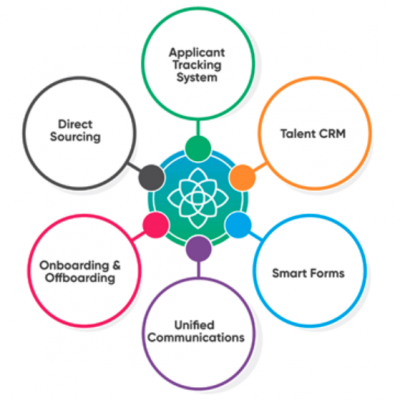The seamlessness that hiring workflows provide is apparent in the name. No matter how rapid or demanding tasks get, there is a sequential order that workflows enable which leads to simplified processes and better outcomes.
However, siloed technologies put a stop to the seamless flow.
Technology silos occur when applications are isolated in their functions and do not allow free-moving data transfer between the various modules. The siloed mentality can be useful when harnessing and reinforcing specialized knowledge and domain expertise, but that’s not the case with contingent hiring.
From adding and managing vendors to creating talent pools and tracking applicants, the objective of every stage of hiring is to achieve optimum outcomes. Having a separate tool for each of them might be enough to get the bare minimum done, but without synergy, the best results are far from reach.
How do Siloed Technologies Cause a Challenge?
1. They widen the divide between business stakeholders
Hiring is the joint endeavour of various stakeholders like HR, procurement, talent acquisition, hiring managers, contingent workforce teams, staffing suppliers, and candidates. All of these users are equally important to the hiring process.
Yet, when provided with separate technology, hiring teams have blinkers on and are focused on their task at hand without visibility or insight into related hiring functions. Rather than working in tandem, the reality is that collaboration is limited or virtually non-existent. And without collaboration, accomplishing common goals and staying true to the company’s vision can be difficult.
2. They are ineffective data resources
Data is one such asset that makes business activities purposeful and relevant. Being contained within siloed technologies makes data counterproductive in many ways.
For one, the same data could be stored in several locations, which turns out to be tedious and time consuming for people to access quickly when they need it. Secondly, when data lives in multiple places, manual processes are required to combine the data and make sense of it. Having to manually update data in multiple places deteriorates its quality and credibility. Moreover, the data could be out of sync, meaning one copy is old and stale while another is up to date, making it difficult to discern which is the best version of data to use.
Last but not least, many organizations are striving to become data-driven, so they can make more intelligent decisions based on access to accurate and up-to-date information. When data is distributed or disparate, being data driven is nearly impossible.
3. They hamper productive decision-making
With technology silos limiting teams’ outlook of the bigger picture, their ability to draw value from data and put it to good use across the board is curbed. It means that organizations do not have visibility, intelligence or insight into information that could be crucial in making decisions. Being forced to take calls at the department level and not holistically can be detrimental to long-term growth and success.
How an Automated Vendor Management System Can Enhance Your Business

1. Attain higher data accuracy and team efficiency
The intelligence of an Automated VMS guarantees that redundancies and errors in data collection and upkeep are significantly reduced. All data exists within a single system, making it easily accessible, eradicating any uncertainty, and minimizing mistakes caused by manual inputs. Data is always up-to-date and enables the extraction of real-time analytics, which can deliver constructive insights on areas that need attention and help make better decisions.
This coherence allows teams to thrive and live up to their true capacity to fill more open positions within days rather than weeks. The ability to utilize unified communication between teams using email, notifications, notes, chat messages, and document management also facilitates and encourages greater collaboration.
2. Make your business rapidly scalable
60% of a recruiter’s day can be eaten up by manual sourcing and under 20% of their time remains devoted to the activities that will have a greater impact, i.e., connecting and conversing with candidates. The personal touch that candidates encounter during the interactions can make the difference between fruitful and failed hires. This is also true for building and maintaining relationships with talent suppliers and other partners.
No business can sustain having recruiters spend much of their day on menial tasks that leave very little time to carry out successful hiring campaigns. Automation flips the switch to free up more hours for candidate and supplier interactions, allowing recruiters to shine and show where their true capabilities lie.
3. Enrich stakeholders’ experience
In addition to facilitating unfettered interactions, automating other practices concerning suppliers and candidates can ensure they are engaged from the get-go.
By automating supplier onboarding, the collection of supplier details and finalizing contracts can be completed in a matter of minutes. Once onboarded, suppliers can be provided with training and AI-fueled job matching that gives them the ability to begin adding value quickly and effectively.
When it comes to candidates, the Automated VMS empowers them with visibility and control of their entire hiring journey, from being up-to-date on open roles and their interview line-up, to handpicking the suppliers who represent them.
4. Enjoy greater functionality in a single system

Prosperix VMS champions the convergence of various functions that include but are not limited to direct sourcing from actively curated talent pools, pre-screening assessments through smart forms, talent pipelining capabilities, a workforce module that expedites onboarding and offboarding, and flexible hiring workflows that support applicant tracking.
All these functionalities being housed within a single system gives you the ability to not only draw the most meaningful insights from your data but also to access multiple capabilities as and when required.
From our perspective, these are the foundational competencies of a smart and unified vendor management system. If you are excited to explore the endless possibilities of an Automated VMS, schedule a demo with us to discover what our Vendor Management System can do for you.

